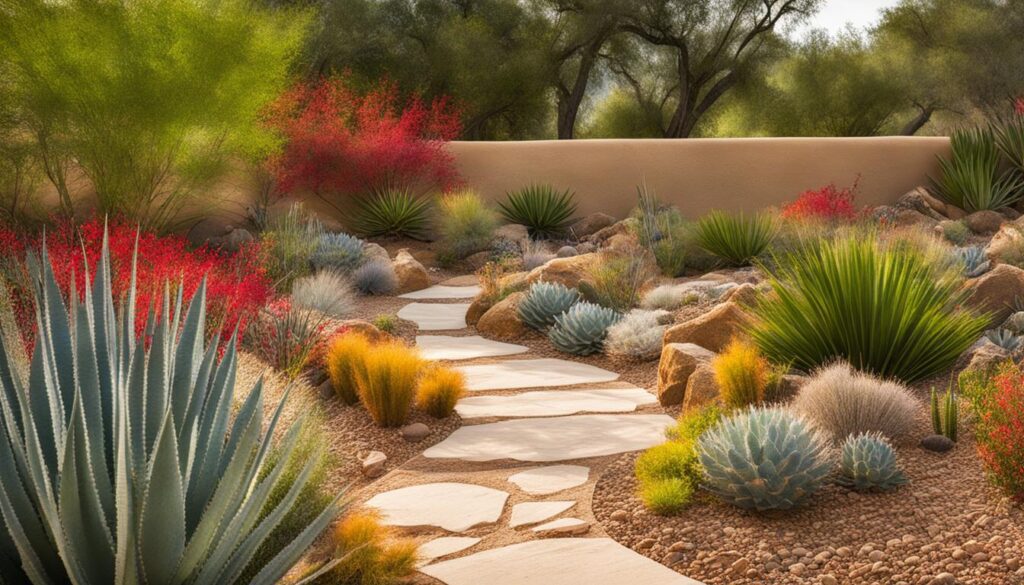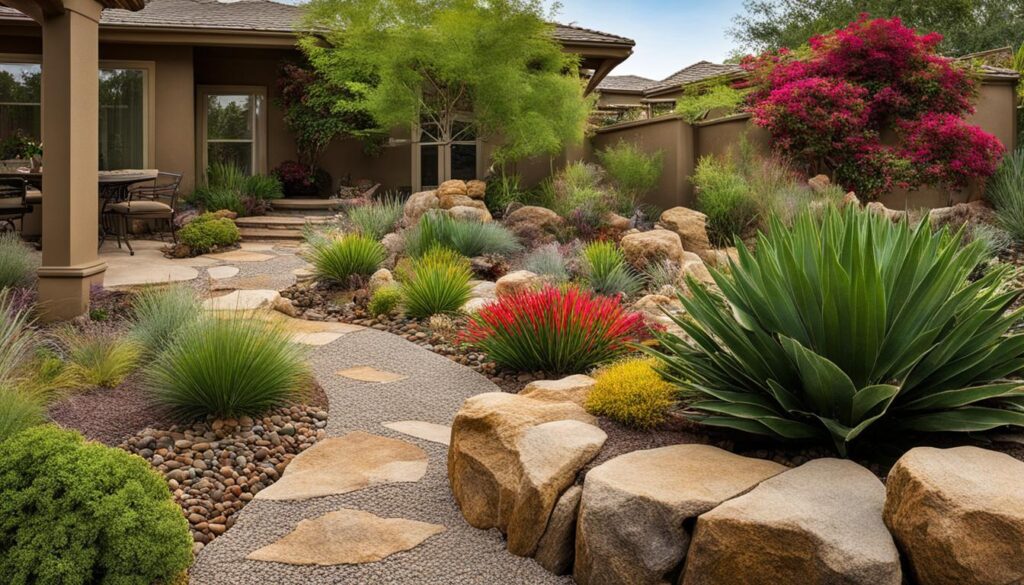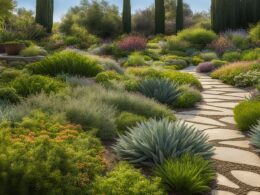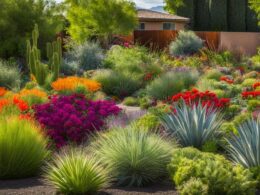Are you looking for a way to transform your backyard into a low-maintenance oasis? Look no further! Sustainable xeriscaping with native flora is the answer. By implementing this landscaping technique, you can create a vibrant outdoor space while conserving water and reducing maintenance.
Xeriscaping involves using potted and drought-tolerant plants, as well as native flora, to create a sustainable and visually appealing landscape. This practice is especially suitable for smaller backyard spaces, allowing you to maximize the use of your outdoor area.
With the seven principles of xeriscaping as your guide, you can easily master this technique. From planning and design to appropriate plant selection and soil improvement, each principle plays a crucial role in creating a thriving xeriscape in your backyard.
Key Takeaways:
- Xeriscaping with native flora is a sustainable landscaping practice that reduces the need for irrigation.
- By following the principles of xeriscaping, you can create a vibrant and low-maintenance backyard.
- Plan and design your outdoor space by dividing it into different zones based on water requirements.
- Improving soil quality is essential for moisture retention in xeriscaping.
- Select appropriate plants that thrive in your local climate and maximize water efficiency through hydrozoning.
The 7 Principles of Xeriscaping
In order to successfully implement xeriscaping in your backyard, it is important to understand and follow the seven principles of this water-saving technique. By incorporating these principles into your landscaping design, you can create a beautiful and sustainable outdoor space that requires minimal maintenance. Let’s explore each of the principles in detail.
1. Planning and Design
In the planning and design phase of xeriscaping, it is crucial to consider the water-saving techniques such as hydrozoning. Hydrozoning involves grouping plants with similar water needs together, allowing for more efficient irrigation. By visualizing your outdoor space and dividing it into different zones based on water requirements, you can create a well-designed landscape that maximizes water efficiency.
2. Soil Improvement
The quality of your soil plays a significant role in xeriscaping. Improving the soil with organic matter such as compost and manure helps with moisture retention and enhances the overall health of your plants. It’s important to choose the right soil amendments based on the specific needs of your plants, as different plants may require different levels of organic matter.
3. Using Appropriate Plants
Selecting the right plants for xeriscaping is essential for water conservation. It is recommended to choose native plants or those that are well-adapted to the local climate. These plants are more likely to thrive with minimal watering. Additionally, incorporating a variety of plants with different heights, colors, and bloom times will enhance the aesthetics of your garden.
4. Landscape Maintenance
Maintaining a xeriscaped landscape requires proper care and attention. This includes regular pruning of trees and shrubs, trimming back perennials, and removing weeds. By keeping your landscape well-maintained, you can prevent water loss and ensure the longevity of your plants.
5. Efficient Irrigation
Efficient irrigation is a crucial aspect of xeriscaping. Using techniques such as drip irrigation or installing a rainwater harvesting system can help optimize water usage. By delivering water directly to the roots of plants and utilizing natural sources of water, you can minimize water waste and ensure plants receive the necessary hydration.
6. Turf Alternatives
In a xeriscaped backyard, it’s important to consider alternatives to traditional turf grass. Grass requires a significant amount of water and maintenance. Instead, you can opt for low-maintenance ground covers, native grasses, or hardscapes like gravel or mulch. These alternatives can not only save water but also reduce the time and effort spent on lawn care.
7. Mulch Benefits
Using mulch in your xeriscaped garden offers numerous benefits. Mulch helps to conserve moisture in the soil, reduce weed growth, and regulate soil temperature. Organic mulches like wood chips or bark also break down over time, enriching the soil with nutrients. By applying a layer of mulch around your plants, you can create a more sustainable and water-efficient landscape.
By following these principles, you can master the art of xeriscaping and create a beautiful, low-maintenance backyard that conserves water and supports native flora. Remember, xeriscaping is not only environmentally friendly but also an opportunity to showcase your creativity in designing a vibrant outdoor space.
Planning and Design for Water-Saving Landscapes
When it comes to creating a water-saving landscape, planning and design are crucial. By carefully considering the layout and functionality of your outdoor space, you can maximize water efficiency and create a visually appealing environment. One effective technique to achieve this is through hydrozoning. This involves dividing your backyard into different zones based on water requirements, allowing you to choose a variety of plants with varying needs.
Visualizing your outdoor space is another essential aspect of planning and design. By sketching a rough draft of your backyard, you can better understand the layout and the potential for different zones. Consider the natural flow of your space and how it can be optimized for water conservation. This process will help you create a well-designed and water-efficient landscape that is tailored to your specific needs and preferences.
Hydrozoning: Creating Water-Efficient Zones
Hydrozoning is a key strategy for water-saving landscapes. By grouping plants together based on their water needs, you can efficiently manage irrigation and reduce water waste. When designing your hydrozones, consider the water requirements of each plant and create zones accordingly. For example, group plants that require more frequent watering in one zone and plants that are more drought-tolerant in another. This targeted approach ensures that each plant receives the right amount of water, leading to healthier growth and minimal water usage.
Hydrozoning is a practical and effective way to conserve water in your landscape. By separating plants with similar water needs into different zones, you can optimize irrigation and reduce water waste. This not only benefits the environment but also saves you time, money, and effort in maintaining your backyard.
Creating an Inviting and Water-Efficient Landscape
During the planning and design phase, it’s important to balance functionality with aesthetics. Consider incorporating elements such as pathways, seating areas, or focal points to enhance the overall ambience of your landscape. By selecting appropriate materials and features, you can create a visually appealing outdoor space that is also water-efficient.
Additionally, don’t forget to make use of natural shade and wind patterns when designing your landscape. Trees and tall shrubs strategically placed can provide shade, reducing evaporation and water loss. Similarly, arranging plants to create windbreaks can help minimize water evaporation and protect more delicate plants from harsh winds.
By focusing on planning and design, you can set the foundation for a successful and sustainable water-saving landscape. The careful consideration of hydrozoning, visualization, and incorporating functional elements will result in an inviting and environmentally conscious outdoor space.
Improving Soil for Moisture Retention
When it comes to xeriscaping, one of the key factors in creating a sustainable and water-efficient landscape is improving the soil for moisture retention. Healthy soil acts as a sponge, allowing roots to access water and nutrients while preventing rapid evaporation. By incorporating organic matter into your soil, such as compost and manure, you can enhance its ability to retain moisture.
Organic matter is rich in nutrients and helps to improve soil structure, allowing for better water infiltration and drainage. It also encourages beneficial microorganisms that aid in nutrient availability and plant growth. The type and amount of organic matter to add to your soil depend on the specific needs of your plants. While some plants thrive in nutrient-rich soil, others, like native plants, may prefer a leaner soil.
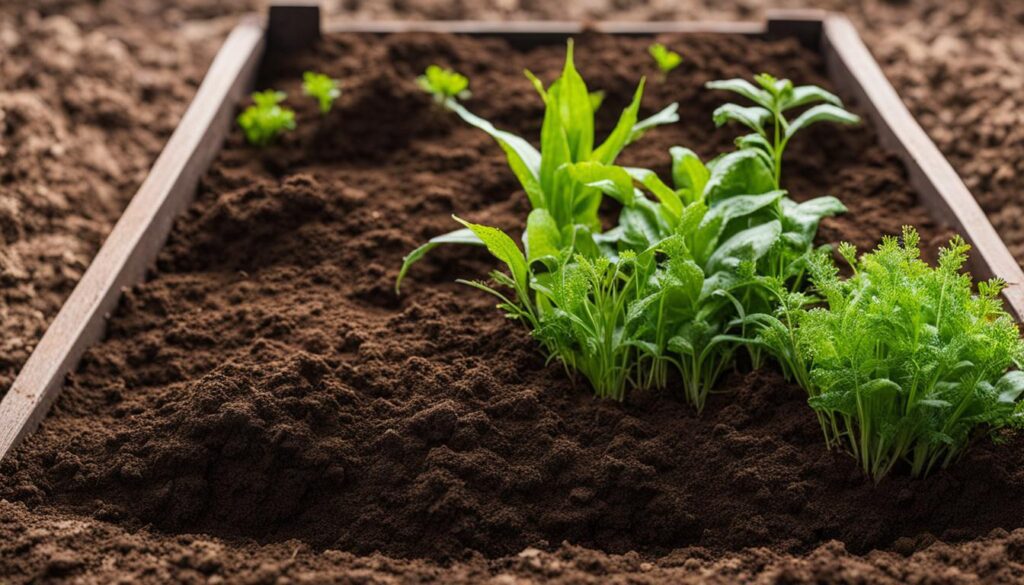
Table: Benefits of Organic Matter in Soil
| Benefit | Description |
|---|---|
| Increased Water Holding Capacity | The ability of soil to retain water is improved, reducing the frequency of irrigation and conserving water. |
| Enhanced Nutrient Availability | Organic matter releases essential nutrients slowly, providing a steady supply of nourishment for plants. |
| Better Soil Structure | Soil with organic matter has improved texture, allowing for better root penetration and oxygen exchange. |
| Promotes Beneficial Microorganisms | Organic matter provides a habitat for beneficial bacteria and fungi that break down organic material, improving soil health. |
Incorporating organic matter into your soil is a gradual process. Start by adding a layer of compost or well-rotted manure to the top few inches of soil. Work it gently into the existing soil, taking care not to damage any existing plant roots. Over time, as the organic matter decomposes, it will continue to improve the soil structure and increase moisture retention. Regularly testing your soil’s moisture levels will help you determine when and how much water your plants need, ensuring efficient water usage in your xeriscape.
Selecting Appropriate Plants for Water Conservation
Choosing the right plants is a critical step in creating a water-efficient xeriscape. By selecting plants that match your hydrozoning strategy, water and sun needs, and native plants that thrive in your region, you can ensure optimal water conservation while enhancing the aesthetics of your backyard.
Hydrozoning and Water-Sun Needs
Hydrozoning involves grouping plants with similar water and sun needs together. This technique allows you to efficiently water your plants and minimize water waste. For example, plants with high water needs, such as ferns and hostas, can be grouped in a zone that receives more irrigation, while drought-tolerant plants like succulents can be grouped in a zone that requires less water.
Consider the water and sun needs of each plant when creating your hydrozoning strategy. Some plants thrive in full sun, while others prefer shade. By arranging your hydrozones based on these factors, you can ensure that each plant receives the optimal conditions for growth and reduce water waste.
Native Plants and Aesthetics
Native plants are well-adapted to the local climate and require less water and maintenance compared to non-native species. Incorporating native plants into your xeriscape not only conserves water but also promotes biodiversity and supports local ecosystems. Research native plants that are suitable for your region and incorporate them into your design to create a sustainable and beautiful landscape.
When selecting plants, consider their different heights, colors, and bloom times. Mixing plants with varying characteristics adds visual interest and ensures year-round beauty in your garden. Choose a variety of plants that complement each other to create a vibrant and visually appealing landscape.
Table: Examples of Appropriate Plants for Xeriscaping
| Plant Name | Water Needs | Sun Requirements | Height | Bloom Time |
|---|---|---|---|---|
| Agave americana | Low | Full Sun | 3-6 feet | Summer |
| Lavandula angustifolia | Low | Full Sun | 2-3 feet | Summer |
| Penstemon strictus | Low | Full Sun | 1-2 feet | Spring |
| Salvia leucantha | Low | Full Sun | 2-3 feet | Fall |
| Achillea millefolium | Low | Full Sun to Partial Shade | 1-2 feet | Summer |
Table: Examples of appropriate plants for xeriscaping, showcasing their water needs, sun requirements, height, and bloom time. These plants are suitable for water conservation and can be used to create a visually appealing landscape.
Maintaining a Sustainable Landscape
Maintaining a sustainable landscape is essential to ensure the long-term success and beauty of your xeriscaping project. While there is some initial effort involved, the maintenance requirements decrease over time as your garden matures. Here are some key aspects of landscape maintenance to keep in mind:
Pruning and Trimming
Regular pruning and trimming of your plants, including perennials, natives, trees, and shrubs, is important to maintain their health and shape. Pruning helps promote proper growth, removes dead or diseased branches, and encourages blooming. By keeping your plants well-maintained, you can prevent overcrowding and ensure optimal water and nutrient absorption.
Garden Maturity
As your garden matures, it becomes more self-reliant and requires less maintenance. Established plants develop stronger root systems, making them more drought-tolerant and less dependent on regular watering. Additionally, native plants are typically well-adapted to the local climate and require minimal care once they are established. With time, your garden will become a thriving ecosystem that requires minimal intervention.
Decreased Maintenance
One of the main benefits of xeriscaping is its low-maintenance nature. By using native plants and reducing water-intensive features like lawns, you can significantly decrease the amount of time and effort needed to maintain your landscape. Xeriscaping also eliminates the need for frequent mowing, watering, and fertilizing, saving you both time and resources. With proper planning and design, you can create a beautiful and sustainable outdoor space that requires minimal ongoing maintenance.
| Key Tips for Landscape Maintenance |
|---|
| Regularly prune and trim plants to maintain their health and shape. |
| Allow your garden to mature, reducing the need for frequent watering and care. |
| Choose low-maintenance plants such as natives to minimize ongoing maintenance. |
| Remove weeds and invasive species promptly to prevent competition for resources. |
| Use organic mulch to suppress weeds, retain moisture, and regulate soil temperature. |
By following these landscape maintenance practices, you can ensure the long-term sustainability and beauty of your xeriscaping project. With a little regular care and attention, your garden will continue to thrive and provide a vibrant outdoor space for years to come.
What Are the Benefits of Using Native Wildflowers in Sustainable Xeriscaping?
Using xeriscaping with native wildflowers in your sustainable landscaping can offer a range of benefits. These wildflowers are well adapted to the local climate, requiring minimal water and maintenance. They also attract native pollinators and wildlife, promote biodiversity, and add a beautiful, natural aesthetic to your outdoor space.
Conclusion
Sustainable xeriscaping with native flora is an excellent choice for creating a vibrant and low-maintenance backyard. By following the principles of xeriscaping, you can achieve a water-efficient and sustainable outdoor space that will thrive with minimal effort.
With a focus on water conservation, xeriscaping allows you to create a beautiful landscape while minimizing your water usage. By using native flora, you can ensure that your plants are well-suited to the local climate, requiring less water and maintenance in the long run.
By improving the soil quality and selecting appropriate plants that are suitable for your region, you can create a thriving and resilient garden. As your landscape matures, it becomes self-reliant, reducing the need for extensive maintenance. This means you can spend more time enjoying your backyard oasis and less time tending to it.
So, if you’re looking to transform your backyard into a sustainable and water-wise paradise, consider embracing the principles of xeriscaping. With its focus on native flora, low-maintenance practices, and water conservation, you can create a vibrant and environmentally-friendly outdoor space that will bring you joy for years to come.






